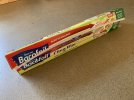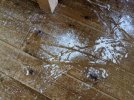- Location
- Herefordshire
The feeders have gone a bit mad the last few days: Siskins, Wood Warblers, Robins, Gold/Green/Chaf finches, Redpoll, Blue/Coal/Great/Long Tailed Tits and some I've probably forgotten.
EDIT - Oh yes: Nuthatch, Greater Spotted Woodpecker, Starling, Tree Sparrows.
EDIT - Oh yes: Nuthatch, Greater Spotted Woodpecker, Starling, Tree Sparrows.




